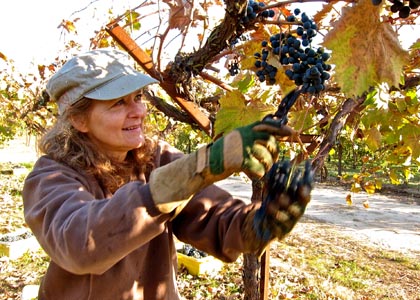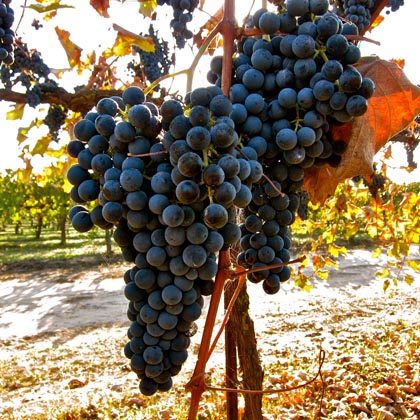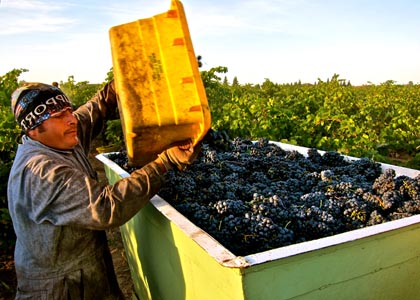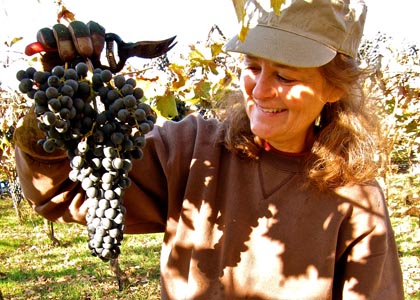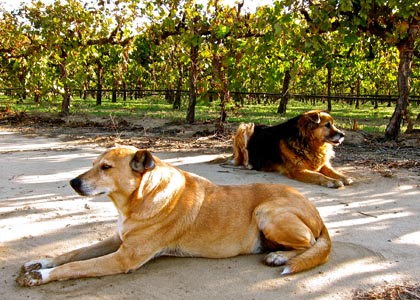Letters from Lodi
An insightful and objective look at viticulture and winemaking from the Lodi
Appellation and the growers and vintners behind these crafts. Told from the
perspective of multi-award winning wine journalist, Randy Caparoso.
2011, Lodi’s canta y no llores vintage
Hux Vineyards' Barbara Huecksteadt picking the last of the 2011 vintage
Lodi winegrowers extol the challenging 2011 vintage
Spectacular Marzemino grapes, ready to go
This past Saturday (October 29), Barbara Huecksteadt was out in her 3.5 acre vineyard next to her home, hand picking the season’s final two rows of grapes all by herself, as she customarily does each year. The grapes were Marzemino — a rare, spectacularly dark, handsome looking grape that originated in Northern Italy, and produces a black, sturdy, wildly aromatic red wine under Huecksteadt’s Hux Vineyards label. As she snipped and lovingly placed each cluster into her trays, she talked about her year, pretty much summarizing the story of 2011 for just about every winegrower in the Lodi AVA during the process:
“Since we knew 2011 would be a cool year like 2010, I pulled leaves aggressively and dropped twice as much fruit as I did last year in order to push ripening,” says Huecksteadt. “Marzemino is always the last grape to ripen — most years in mid-November. Last year we barely got it to ripen past 22° Brix (i.e. sugar reading), and we ended up with less than half a ton. 2011 is another small crop, but at least I’ll get a full ton. The Brix is at about 23.5° — not as much as I’d like, but it will still produce intense wine, and you can see how beautiful the clusters are… almost no rot, despite the rains earlier in October.”
David Akiyoshi, the winemaker of the much larger scaled LangeTwins Winery & Vineyards who has worked over 30 harvests here in the Delta, summarizes the 2011 harvest as “nothing but curveballs and change-ups.” Then again, he reminds everyone, “there is no such thing as normal” in winegrowing.” Or, as Tom Hanks might put it, “there’s no crying in baseball!”
The LangeTwins' Lewis Vineyard Zinfandel, fully ripened and picked well before the October rains
The signs that Mother Nature would be stepping in and having her say came early this year. Says Akiyoshi, “April showers brought May flowers, but showers in May brought us a prolonged fruit set” – resulting in variable berry ripeness within each cluster. Fewer berries in each cluster means lower cluster weights, and ultimately, lower overall yields. Zinfandel, one of Lodi’s bread-and-butter, was especially light, according to Akiyoshi, “due to shot berries (unfertilized fruit) which fell off the clusters while still green.” Growers reported Zinfandel yields down anywhere from 10% to 30%, depending upon the site.
“Fortunately the cooler summer weather allowed for much longer fruit development time,” Akiyoshi tells us, “which helped even out the ripening.” The important thing is that “sugar accumulation did not outrace flavor development. Grapes showed nice flavors even at a lower Brix, so we still ended up with brighter, fresher white wines than ever. Red wine grapes enjoyed the cool summer and moderate fall temperatures, which gave grapes plenty of time to mature and allow the tannins to develop fully, tasting less harsh.”
Lower grape sugars means more lower sugar-to-alcohol conversions, which are right up the alley for more and more of today’s consumers, tiring of super-ripe, high alcohol wines of the recent past. Ryan Leeman, the winemaker at Van Ruiten Family Winery, puts it simply: “2011 is a lower alcohol year.” Therefore, if you prefer more balanced, lower alcohol wines, “this is your year in California to show Lodi some love.” However, warns Leeman, smart consumers should be cognizant of the fact that “quantity is down as much as 40% from last year… stock up on your favorite values, because supply will be shrinking, causing prices to rise”
Aye-yi-yi, canta y no llores…
Huecksteadt personally picks all her own Marzemino
Never one to cry over spilt grapes, Akiyoshi gives a play-by-play on how the 2011 harvest unfolded: “The harvest schedule was very scatter-shot; not many tight groupings by grape variety. There were only a couple of big harvest days, mixed in with days of having no grapes picked at all. We had a couple of Sundays when fruit poured in (grapes don’t comprehend the concept of ‘weekend’), but overall, it was more of a vineyard-by-vineyard call when to pick, which allowed a greater flexibility in harvest decisions.
LangeTwins' David Akiyoshi
“There was some rain on our parade later in the season. The first rain, during the first week of October, came after our Zinfandels (notoriously thin skinned, and thus susceptible to rot) were in the winery, so we felt pretty fortunate. After the second rainfall, the following week, we only had a couple of the more Bordeaux varieties like Cabernet Sauvignon (thicker skinned, thus more resistant to rot) left to harvest, and so we could still wait for ripeness.”
Since winemakers tend to be glass-half-full type personalities, it’s a rare one that says it like it is. Michael McCay of McCay Cellars describes 2011 as “the year of the great, the good, the bad and the ugly.” The growing legion of fans of McCay’s Truluck’s and Jupiter Zinfandels, for instance, should expect glorious wines from 2011 — well balanced, intense, and generally between 14% and 15% alcohol, which is very moderate for Zinfandel from anywhere in the state. But his estate grown Petite Sirah suffered from the October 10th rains — “berries split open and rot set in… we picked it, but I’m not sure if we’re going end up using it.”
Chad Joseph – who consults for Lodi’s Harney Lane, Harmony Wynelands, Valhalla Vineyards, and McConnell Estates – describes 2011 as “would’ve, could’ve, should’ve… we would have loved to let the fruit hang, if wasn’t for the rain. We brought fruit in that really wasn’t ripe technically, not only in Brix, but also in tannin, acid and flavor maturity. We had another unexpected rain after the first shower that really wreaked havoc on the fruit, bringing on serious breakdown. Even Cabernet Sauvignon was showing signs of this stress, so we were forced harvest to preserve fruit quality, which pretty much ended the season.”
Ah, but then the sun comes out from behind the clouds in Joseph’s coffee, when making the qualification, “it’s important to remember that these later ripening vintages bring wines lower in alcohol, higher in acid, and thus, more potential for aging – overripe fruit is not always the path to outstanding wines.”
It’s Yogi Berra who said “it ain’t over ‘til it’s over.” Then again, he’s also famous for experiencing “déjà vu all over again,” which can very well describe Lodi’s 2011 harvest: another one to sing on home!
Slow moving natives of Hux Vineyards
